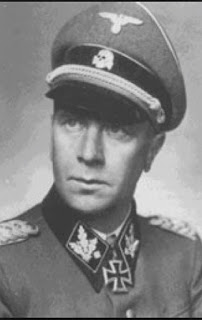 |
| Montreal, 1948. Front row L to R: John, Spike (O.S.S.), Liz, Hilda, Sheila. Back row, L to R: Olga, Randal, Brigid. |
These intelligence workers were gagged when the war was over and they returned to civilian life.
1. Malcolm Nance
A member of the board of the expanding Spy Museum in Washington, D.C., Malcolm Nance, was visiting East Hampton, N.Y. over the weekend to promote his books – Hacking ISIS and The Plot to Hack America (both New York: Skyhorse Publishing, 2017).
Malcolm is interested in the stories of spies from a family perspective and is seeking memorabilia related to them fro the museum He spoke with Michael and me about our fathers' work in espionage.
This post is about these two Americans in Europe during the war doing intelligence work, how their children came to find out what their fathers did, and the connection between them.
2. E. R. (Spike) Marlin, Dublin and London
My Dad, E. R. "Spike" Marlin took a competitive exam to work in FDR's government in 1933 and was one of about 300 who was awarded a position, out of thousands who applied. His first job was at the Farm Credit Administration under Henry Morgenthau, Jr. – before Morgenthau succeeded William H. Woodin as Secretary of the Treasury.
 |
| L to R: Michael Collins and Malcolm Nance. Photo by JT Marlin. |
Spike's primary qualifications were that he had (1) already established a decade-long U.S. Government service record in Washington, D.C. and (2) as a graduate of Trinity College, Dublin he knew many residents of Éire.
The United States recognized the Irish Free State in 1924, after various legislative processes established partition between the six counties that make up Northern Ireland and the 26 that make up the Irish Free State. The United States did not send a full Ambassador to Éire until 1950. From 1940 to 1947 the U.S. "Envoy Extraordinary and Minister Plenipotentiary" (shortened in practice to "Minister") was David Gray, Jr. (1870-1968), a novelist and playwright whose two main qualifications were that he (1) was married to Eleanor Roosevelt's aunt and close confidante Maude Hall Gray (1877-1952) and that he (2) had spent a lot of time in Cork writing a book and enjoying the excellent local hunting and fishing. Gray, who was 70, told his predecessor he wanted the post (http://bit.ly/2uYmwN3) and it was offered to Gray when the previous incumbent returned home.
Gray was unique as a U.S. envoy in that he was actively hostile to its leader, Éamon de Valera. As an opponent of the neutrality of the Éire government, Gray accused the Irish Free State of cooperation with the Nazi Axis. O.S.S. chief "Wild Bill" Donovan was sympathetic to the Éire government's need to maintain its neutrality given the recent history of partition, and wanted to find out whether Éire was cooperating fully with British intelligence. My father, reporting to Francis Pickens Miller in London, collected evidence that showed that the Éire government was working closely with British intelligence. Both the presence of the O.S.S. and my Dad's success in collecting the information that Donovan expected him to find were thorns in Gray's side.
Eventually, having done his work, Spike was reassigned to O.S.S. in London and a new spy was recruited who was not assigned to the U.S. mission and had the cover (revealed in a book Spies in Ireland) of a movie producer. I have spoken with the author.
After the war was over and the O.S.S. was disbanded, Spike was sent to San Francisco as a Budget Bureau representative to the formation of the U.N. He was seconded to the Provisional International Civil Aviation Organization (PICAO) as Secretary and headed the secretariat for the creation of the ICAO in Chicago. FDR in January 1939 ramped up his interest in manufacturing airplanes and that year he showed his interest in aviation by making Orville Wright's birthday on August 19 (this coming Saturday) as National Aviation Day. Spike then joined the United Nations and became Director of Technical Assistance for the ICAO in Montreal. He spent the next two decades working for the U.N., ending as the highest-ranking American at the UNHCR in Geneva under Ambassador Félix Schnyder (who was the High Commissioner in 1960-65) and Sadruddin Khan. Spike then served in the State Department for three years in 1964-67 when I was working across the road for the Federal Reserve Board.
I didn't discover that my Dad had been in the O.S.S. until the 1970s, when a Ph.D. student contacted me with questions.
 |
| Sgt. Tom Collins |
My neighbor Michael Collins didn't find out that his father Tom was in the cryptography area until the end of the last century.
Sgt. Tom Collins was selected at 19 years of age to accompany the American Dragon 1 cryptographic machine, essentially an early computer.
His primary qualification is that in his civilian life before his war service, he was a telephone installer for Western Electric and would understand the wiring protocols for the machine that the company developed with U.S. cryptographers to crack the German code. He accompanied the Dragon 1 to Bletchley Park and spent year at the Park assisting British cryptographers under Turing with the maintenance of the Dragon 1.
References
1. Malcolm Nance: Hackers and MICE
2. E. R. (Spike) Marlin: Origins of the O.S.S., Post at ICAO
3. Tom Collins and his work in Bletchley: CRYPTOGRAPHY | Americans at Bletchley Park . VET STORIES | Tom Collins, 1921-2011 . BLETCHLEY | U.S. Contribution to British Cryptography . VETS | The Funeral of Tom Collins
4. Spy Museum: Spies' Choices




